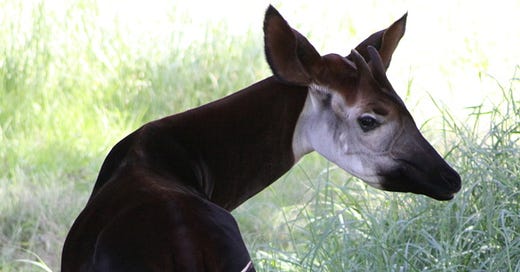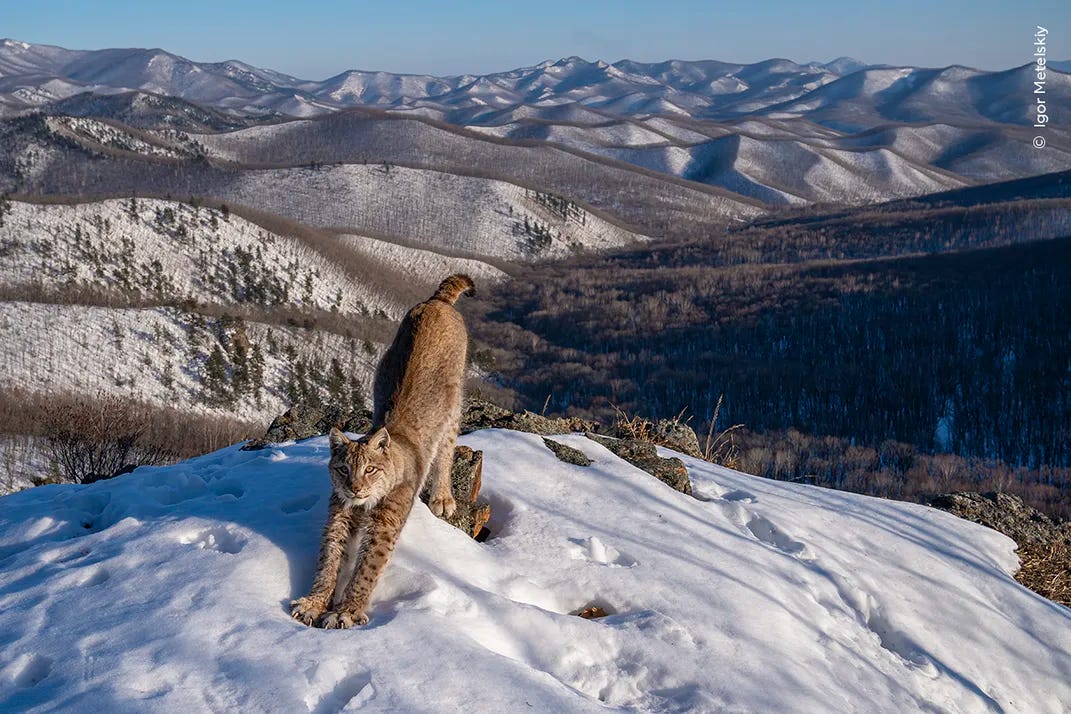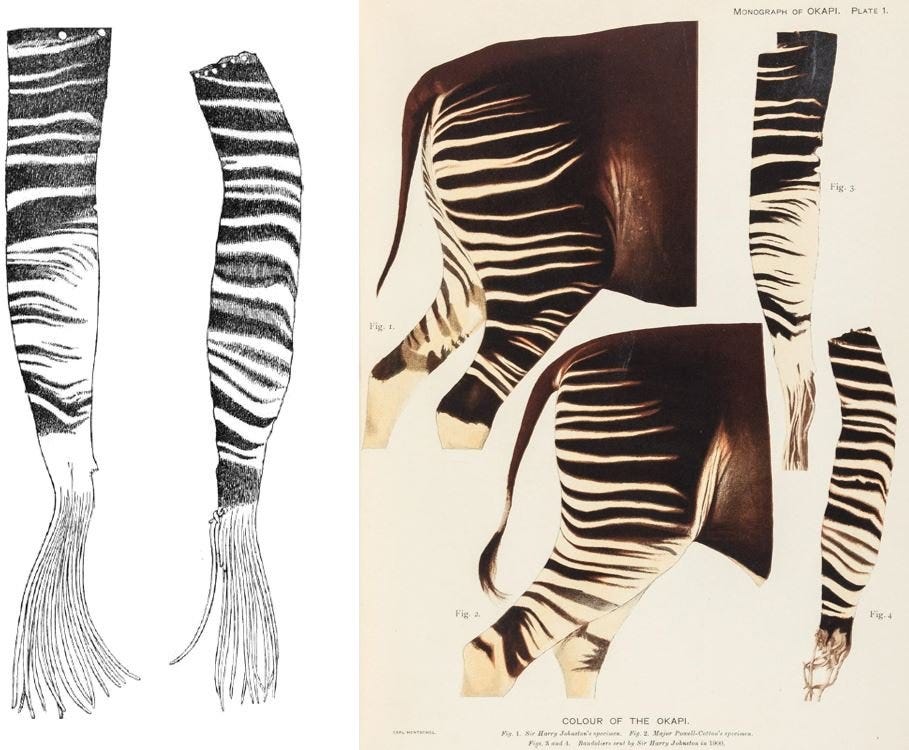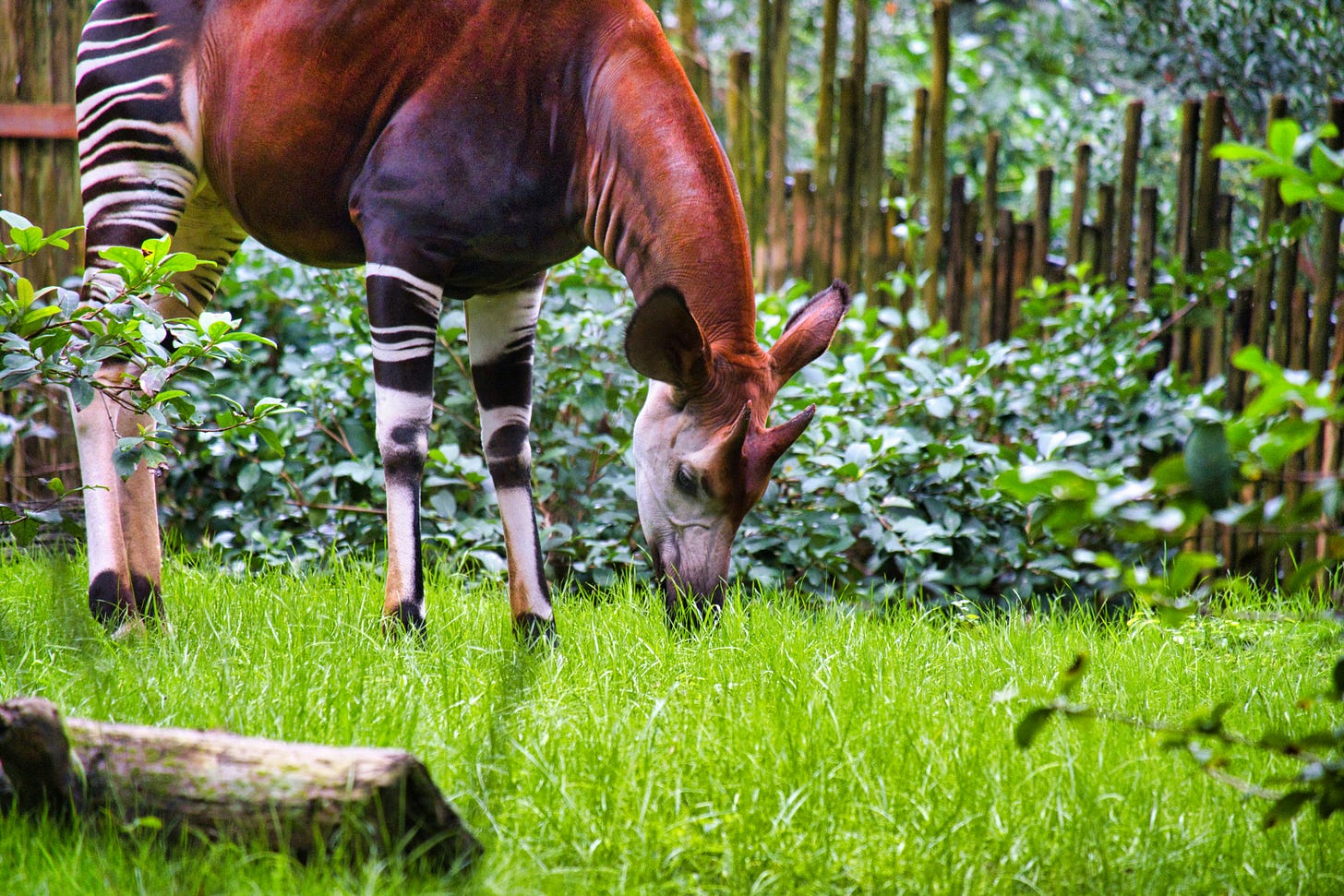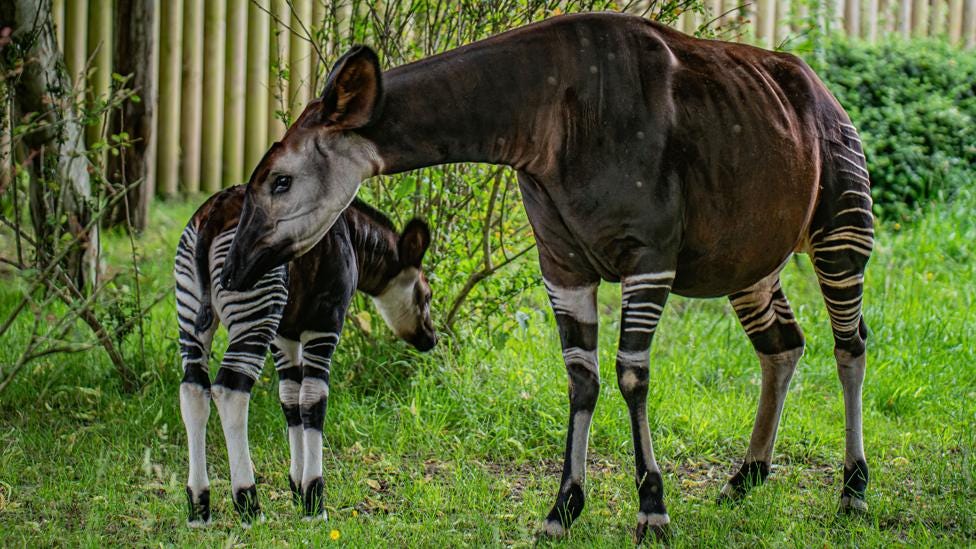Hi, it’s Ben and Charlotte, welcome to The Entmoot.
In this week’s issue we'll look at:
Winning images for Wildlife Photographer of the Year 2024
The Observer's view on climate change
The best plants for mental health – 7 professional picks for a calming garden
Species Spotlight - The Okapi
And more…
Lit by the early evening sun, a lynx stretches majestically in front of snowy mountains in Russia. © Igor Metelskiy, Wildlife Photographer of the Year
Best links
Wildlife Conservation
Winning images for Wildlife Photographer of the Year 2024 (Positive News)
Time to make wildlife conservation luxurious (Travel and leisure)
Wildlife loss is taking ecosystems to the brink of collapse (The Conversation)
Climate Change
How late is too late to act on climate change? (Tax research)
The Observer view on climate change (Guardian)
Zoo news
Animal activists win legal bid to block zoo plans (BBC)
Gary Shapiro’s half-century journey from zoos to the wilds of Borneo (Mongabay)
Botany
The best plants for mental health – 7 professional picks for a calming garden (Homes and Gardens)
Jobs
Zoo keeper positions are available at Exmoor Zoo, New Forest Wildlife Park and London Zoo (Wild Professionals)
Find the latest environmental, Ecology, and fundraising positions here (Environmental jobs)
Featured Article
Species spotlight - Okapi
With World Okapi Day approaching, we thought it would be worth taking a look at this fascinating species for this week’s newsletter.
The okapi is a herbivorous mammal native to central Africa, and even though their stripey appearance might have you thinking they are a cousin of the zebra, they are actually the closest living relative of the giraffe and the only other extant member of the family Giraffidae, which shares a common ancestor with deers and cows.
The Okapi is one of the most recently discovered large mammals, having first been classified within the western world by Sir Harry Johnston in 1901. One of the reasons why the okapi may have been found so late is the remote location in which it resides - living amongst dense vegetation at high altitude it is hard to spot and well camouflaged thanks to its unique markings.
Before being discovered by western taxonomists, it was revered in folklore by the native population and earned the name ‘The African unicorn’ due to how little it was seen.
Description
The Okapi stands at around 1.5m in height and is about 2.5m long, weighing between 200-350kg with females being slightly bigger and heavier than males and having a typical lifespan of around 20-30 years.
Their skin can range from a dark chocolate colour to a brighter reddish brown, and most notably have black and white stripes covering their hind quarters and front legs.
Their dark skin allows the Okapi to blend into their environment for greater protection from predators, which is predominantly the leopards that occupy the same habitat. The stripes are believed to serve two purposes - the first being greater camouflage because, similarly to zebras, they break up their outline and cause predators to have misjudgements in depth perception when in high-speed pursuits. The second is that they may help young find and stay close their mothers amongst dense vegetation.
Okapi present with sexually dimorphic features, meaning that males and females each possess different characteristics. One such feature in the Okapi is the presence of ossicones, which are short, hairy, horn-like structures found only in males and used in the same way giraffes do; as weapons for fighting, usually over females. Ossicones will also be judged by their mates to rank stronger males - the bigger the ossicone, the more viable the offspring.
Much like their relative, the giraffe, Okapi have long, dark purple tongues that measure around 18 inches in length. This prehensile instrument is useful for reaching and grabbing edible vegetation, and possesses excess melanin to protect from sunburn.
Diet
As mentioned earlier, okapis are herbivores and have a varied diet, including grasses, ferns, fruits and mushrooms. They have been known to feed on over 100 different species of plants and fungi, aided by their long tongues which aid them in reaching various high-growing plants unavailable to many other animals. To support their weight, Okapis will usually consume between 20-30kg of food per day.
Like many other hoof-stock species, okapis are ruminants. This means that like domestic cows, they have a four-chambered stomach that allows better digestion and breakdown of the complex cell walls found in vegetation.
Behaviour
Okapi are primarily diurnal (active during the day) and are occasionally active for a few hours at night. They are usually solitary, coming together only to breed, and have no particular mating season, with females coming into oestrus every 15 days. Males are very territorial and will scent-mark their range, but will allow the presence of females for mating purposes. These territories usually overlap, with males being migratory while females remain more sedentary - this allows for multiple males to come into contact with females for a genetically diverse and therefore more resilient population.
Gestational periods are around 440-450 days, where typically only one calf is born. Calves will stay with their mothers for 1-2 years until they are fully developed and can fend for themselves. Like many prey species that need to become mobile quickly, okapi young can stand within 30 minutes of being born in order to stay close to their mothers and outrun predators.
Conservation status
Okapi are classified as endangered by the IUCN. Because of their elusive nature, it has been hard to get an exact figure on how many remain, but some estimates put it as low as 5,000 individuals with numbers believed to have halved in the last 25 years.
They are protected under Congolese law, however, there are still many threats to their survival, including:
Habitat loss - even though their habitat is ‘protected’, this hasn’t stopped it from being eroded by illegal mining and logging activities. Nearly 7% of their already limited habitat has been lost since the turn of the century
Hunting - Again, even though the species is protected, this hasn’t stopped them from being extensively hunted. The illegal activities in the area have allowed easier access to the okapi’s territory, which has allowed to the local people easier access to hunt this species for food and their striking skins
Collateral damage - As well as being purposefully hunted, this species lives in a very volatile area in terms of human conflict. Many Okapi are killed in the local conflicts that ravage central Africa
What is being done to protect them?
There are many organisations working to protect this endangered species, one of the most notable is the Okapi Conservation Project. They help by monitoring numbers and keeping track of territorial ranges, whilst maintaining the local ecosystem to ensure there is enough food to support the okapi population.
Another way that they are protected is by the funding and training of local eco-guards. These rangers have special jurisdiction to be able to prevent illegal activities in the okapi’s territories in order to reduce poaching and habitat loss.
There is also an extensive captive population in zoological collections around America and Europe. These zoos continue to provide stock for wild release as well as a ‘backup’ population in case they become extinct in the wild.
What can we do to help?
As with most conservation issues, by caring for the local human population we can help to protect nature. Humans are part of the ecosystem, and when they are starving due to food insecurity caused by ongoing conflict and relying on whatever they can find for food, the protection status of an animal that could help to feed their family doesn’t really factor into it.
As always, this is a complicated issue that doesn’t have a quick fix. But by helping to ease conflicts, people and wildlife can begin to coexist in a stable way that is mutually beneficial. To find out more information on the conflict in the DRC and donate, click this link: https://www.rescue.org/article/crisis-drc-what-you-need-know-and-how-help.
The okapi is a special animal. Often overlooked as just another of Africa’s large herbivores or even unheard of completely, they play an important role in their ecosystem and are a unique addition to a diverse animal kingdom that we can’t afford to lose.
World Okapi Day is Friday the 18th of October. If you can, please consider donating to the Okapi Conservation Project. If you are not in a position to do this, perhaps you could consider consider sharing content related to the okapi to raise awareness - share this publication, comment and like. Let’s try and get the Okapi the boost in attention it needs to increase awareness and encourage more people to help protect this wonderful species.
Thank you for joining
If you have enjoyed this week’s newsletter, let me know in a comment or share so more people can get involved in the conservation conversation. Thanks for reading and see you again next week.

